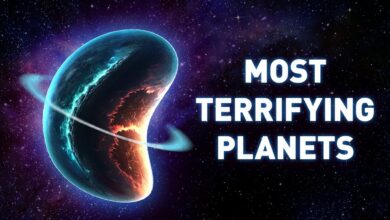What Would Happen During a Glass Moon Eclipse?
Initial simulation and hypothesis of the “death ray”:
Imagine that the Moon, in its current size and shape, was completely replaced by a giant glass sphere. One of the initial hypotheses was that during a total solar eclipse (when the Moon completely covers the Sun), this glass sphere could act as a giant magnifying glass.
A magnifying glass, when placed in sunlight, can focus light into a powerful beam at a single point. Therefore, the hypothesis was that the glass Moon would collect and focus sunlight into a beam of light, creating an extremely powerful “death ray” that would hit the Earth, enough to cause fire or destruction at this focal point.
Testing the hypothesis through simulation:
To test this hypothesis, the author used an advanced light physics simulation software, which allows modeling how light interacts with a large glass sphere. The simulation results show that, due to the Moon’s enormous size and curved surface, sunlight cannot be focused enough to create a powerful beam. Instead, light passing through the glassy surface of the Moon is refracted and scattered in many different directions. This is completely different from the way light behaves in a small magnifying glass on Earth.
Refraction and scattering of light:
Refraction occurs when light passes from one medium (e.g. space, vacuum) into another medium (e.g. glass), its direction is changed due to the difference in the speed of light in these media. On a large glass sphere like the Moon, sunlight will be refracted as it passes through many different points on the surface of the sphere. This results in the light not being focused into a single point but being scattered around, minimizing the focusing effect as in a small lens.
This experiment was further verified using a small glass sphere (representing a model of a glass Moon) under realistic lighting conditions. When sunlight passes through the glass sphere, although it creates some small focal points, they are very close to the surface of the sphere, unable to shine brightly enough to cause damage to anything more than a few centimeters away.
Results of a solar eclipse with a glass Moon:
Due to the scattering of light, the shadow cast during a solar eclipse with a glass Moon is almost the same as the shadow cast by a current stone Moon. The shadow will still create the eclipse phenomenon as we know it: a shadow covering part or all of the Sun as seen from Earth. However, if the Moon is indeed glass, sunlight may create some strange refraction effects in the sky, causing the sky around the eclipse to appear haloed or have a slight rainbow effect due to the light being scattered through the glass Moon.
Conclusion:
After simulations and experiments, the conclusion was drawn that the glass Moon cannot create the “death ray” as originally hypothesized. The light from the Sun would be refracted and scattered in many directions, not concentrated enough to cause damage on Earth. An eclipse with a glass Moon would look quite similar to the current eclipse, although there may be some unusual light effects appearing in the sky. This shows that while the idea of a glass Moon is appealing, physical reality will still dominate and limit any “death” effects.
The lessons from this hypothesis help us better understand how light works and the interesting astronomical phenomena that can occur when we change one element in the solar system.









